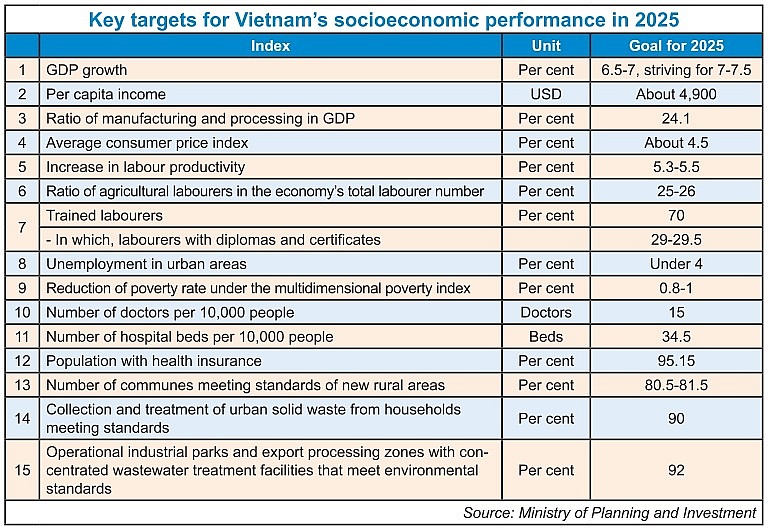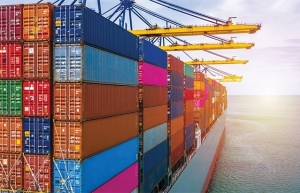Economic growth surpassing targets
 |
Last week, the government reported to the National Assembly (NA) that the economy’s scale for this year is estimated to reach $473.5 billion, up from $430 billion in 2023.
“The entire economy is in a positive recovery phase, regaining the growth momentum seen before the pandemic. Economic growth has surpassed the set targets, with macroeconomic stability maintained, inflation controlled, major balances ensured, and budget overspending curbed,” noted the government in its report to the NA.
The government has proposed a new target for economic growth of about 6.5-7 per cent next year, with efforts to achieve a rate of 7-7.5 per cent, depending on better conditions both domestically and internationally. By the end of 2025, Vietnam’s economy is expected to rank between 31st and 33rd globally in terms of GDP.
According to the World Bank, by the end of 2023, Vietnam’s GDP ranked 34th globally, reaching $430 billion.
The government has also set 15 key economic goals for next year. To realise these, it will implement a range of solutions to stimulate the economy.
“Fiscal and monetary policies will work in tandem with other measures to address bottlenecks and remove obstacles for business and production activities, prioritising economic growth, maintaining stability, controlling inflation, and ensuring major economic balances,” said Minister of Planning and Investment Nguyen Chi Dung.
The Vietnamese government will also “actively, flexibly, promptly, and effectively” manage monetary policy, regulating interest and exchange rates in line with macroeconomic developments, while ensuring capital flow for the economy.
“It is crucial to manage credit growth reasonably to support economic growth. The government will continue to guide commercial banks to reduce operating costs, increase the application of IT, and accelerate digital transformation,” Minister Dung noted. “Credit growth will be prioritised for production, business sectors, and economic growth drivers, including social housing, green growth, digital transformation, and the circular economy.”
Robust recovery
In the first nine months of 2023, the economy grew by 6.82 per cent, compared to 4.4 per cent in the same period in 2022. The Ministry of Planning and Investment (MPI) estimates the economy will grow by 6.8-7 per cent this year, surpassing the NA’s target of 6-6.5 per cent.
Vietnam’s growth potential continues to be highly valued by the international community. The World Bank, International Monetary Fund (IMF), and Asian Development Bank (ADB) all projected growth rates of around 6 per cent for Vietnam in 2023.
The IMF has recognised Vietnam as the only ASEAN nation among the top 10 economies with the highest growth rates globally, forecasting a 6.4 per cent average growth rate for 2024-2029.
“Vietnam’s economy showed robust recovery in the first half of 2024 and continues momentum despite global uncertainties. This steady recovery has been driven by improved industrial production and a strong rebound in trade,” said the ADB which also forecasted that the economy will grow 6.2 per cent in 2025. “Trade recovery and foreign investment should be key growth drivers this year.”
FocusEconomics last week said that turning to Q4, the economy is expected to expand at a slower pace than in Q3, hampered by the lingering effects of Typhoon Yagi.
FocusEconomics forecasts that the Vietnamese economy will grow 6.3 per cent this year. “We forecast GDP growth to accelerate in 2025 from 2024’s projection and remain among the fastest in ASEAN. An improvement in fixed investment growth, paired with healthy expansions in private and public consumption, will underpin momentum,” the analysts said.
“Additional extreme weather events plus regional war in the Middle East are downside risks. FocusEconomics panelists see GDP expanding 6.5 per cent in 2025, which is up by 0.1 percentage points from one month ago, and climbing 6.4 per cent in 2026.”
In its recent macro-economic updates about Vietnam, Standard Chartered Bank forecasts the country’s 2024 GDP growth to 6.8 per cent (from 6.0 per cent), reflecting stronger-than-expected Q3 GDP. For Q4, growth is expected to moderate to 6.9 per cent. The 2025 forecast remains at 6.7 per cent, with projected growth of 7.5 per cent on-year in H1 and 6.1 per cent on-year in H2.
Additionally, the ASEAN+3 Macroeconomic Research Office has projected a 6.2 per cent growth for Vietnam in 2024, driven by a recovery in export demand and strong foreign direct investment (FDI) inflows, with growth potentially reaching 6.6 per cent in 2025.
| Coordinated policies are essential to support economic recovery amid rising prices and weak demand. In the near term, monetary policy must be closely aligned with fiscal policy to effectively stimulate economic activity. Monetary policy will aim to balance price stability and growth, though policy space is limited, and the heightened risk of non-performing loans poses constraints on further monetary easing. Significant uncertainties loom, including weaknesses in the domestic economy’s structural foundations and subdued global demand, which could hamper exports, manufacturing, and employment. Vietnam’s exports are facing increasing competition due to shifts in global value chains and geopolitical tensions, particularly in sectors such as garments, textiles, and electronics. To sustain growth momentum through 2024 and 2025, macroeconomic stability must be preserved through a balanced mix of monetary and fiscal policies, complemented by comprehensive governance reforms. Weaker-than-expected external demand may require additional policy measures to stimulate domestic demand and support businesses. While the State Bank of Vietnam continues its accommodative monetary policy, its capacity is increasingly constrained. Enhanced fiscal support, increased public investment disbursements, and further governance reforms are needed to reduce the burden on monetary policy and bolster economic growth. Source: Asian Development Bank |
A key driver of growth
In recent years, Vietnam’s share in global FDI has risen along with countries in the region, despite a decline in global FDI since 2020. In part, this reflects the interest of foreign investors in the growing domestic market.
Vietnam, due to rising geo-economic fragmentation, has seen some trade and FDI reallocation with foreign investors moving production to Vietnam, for example, the share of domestic value added in its exports to the US surged in 2018, the IMF said.
In the first nine months of 2024, total registered FDI into Vietnam is reported to have reached nearly $25 billion, up by more than 11.6 per cent as compared to the same period last year. The MPI has predicted that the industrial sector will continue its recovery trend, with an 8 per cent growth on-year in 2024, serving as a key driver of economic growth. The agro-forestry-fishery sector is expected to grow by 3.4 per cent on-year, while the service sector is forecasted to increase by 7 per cent.
Data from the General Statistics Office shows that the industrial sector’s added value in the first nine months of this year expanded by 8.34 per cent, with the manufacturing and processing sector rising by 9.76 per cent.
The economy has also seen nearly 122,000 newly established businesses, with registered capital totalling $48.27 billion, both up 3.4 per cent on-year. Moreover, around 61,100 enterprises resumed operations, a 25 per cent increase compared to the same period last year.
The World Bank also pointed out some domestic downside risks. If macroeconomic stability were to weaken, consumer confidence could erode further, affecting consumption and investment. The real estate market recovery could take longer than expected, adversely impacting private sector investment, an important contributor to economic growth.
“If the financial sector’s asset quality were to weaken further, bank lending capacity could be undermined,” the World Bank said. “As one of the world’s most vulnerable countries to climate change, increasingly intensifying natural disasters pose additional downside risks.”
 | IMF predicts Vietnam's economic growth to reach 6.1 per cent in 2024 Vietnam's economic growth is projected to recover to 6.1 per cent in 2024, supported by continued strong external demand, resilient foreign direct investment, and accommodative policies, according to International Monetary Fund (IMF). |
 | Issues acknowledged in growth mission Vietnam’s economic growth is expected to accelerate by the end of 2024, partly fuelled by a rise in foreign investment, but medium-term growth prospects will face headwinds. |
 | Key ministries ink deal to boost security and economic growth The Ministry of Public Security and the Ministry of Planning and Investment (MPI) have agreed to enhance cooperation in public investment, crime prevention, and digital transformation. |
What the stars mean:
★ Poor ★ ★ Promising ★★★ Good ★★★★ Very good ★★★★★ Exceptional
Related Contents
Latest News
More News
- Ho Chi Minh City backs $2 billion AI data centre with dedicated task force (January 06, 2026 | 08:43)
- PM sets January deadline for high-speed rail consultant (January 06, 2026 | 08:40)
- New decree spurs on PPP implementation (December 31, 2025 | 19:01)
- Global alliance develops $1 billion AI data centre network in Vietnam (December 30, 2025 | 10:08)
- Standing out in the Chinese outbound investment wave (December 29, 2025 | 10:29)
- Bright spots obvious in foreign investment mission (December 29, 2025 | 09:00)
- Ho Chi Minh City hits $8.37 billion in FDI (December 29, 2025 | 08:28)
- Vietnam and UK cooperation backs finance talent for IFCs (December 27, 2025 | 16:31)
- Global partnerships key to Vietnam’s IFC development (December 26, 2025 | 16:18)
- Vingroup pulls out of bid to invest in North-South high-speed railway (December 26, 2025 | 11:42)

 Tag:
Tag:

















 Mobile Version
Mobile Version